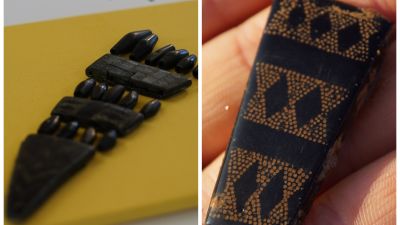'Beautiful' 4,000 year-old Bronze Age necklace goes on display in the Isle of Man

A 4,000 year-old Bronze Age necklace and bracelet has gone on display for the first time.
The items, discovered in 2018, are on show in the Manx Museum in the city of Douglas.
People will be able to see parts of the necklace, but it is not yet in good enough condition to be displayed as one.
The 122 beads were found during the Round Mounds of the Isle of Man project, which aims to "investigate prehistoric round mounds” on the Island.
The mounds are ancient burial sites which can date back to at least 1,000 BC. Often, significant members of society were buried with valuable items.
"This collection of artefacts in particular is really remarkable."
"These are all early Bronze Age and date from around 2000 BC", said Allison Fox curator of archaeology at Manx National Heritage.
"They have had some careful cleaning and conservation work as jet is quite a fragile material, it is prone to splitting.
"But even though these have been in the ground for so long, when they came out these barrel shaped beads here that you can see pretty much perfect."
The necklace and bracelet was found on an excavation site at Berk Farm in Kirk Michael.
"We suspected we'd find pottery, which we did some burial pottery, and also some other prehistoric artefacts like flint", added Alllison Fox.
"But I think it's fair to say none of us were really expecting artefacts of this quality."
The bracelet, necklace and fastener have recently been deemed as 'treasure' after an inquest, meaning that they now belong to the state.
The Round Mounds Project is a four-year research scheme and was a collaboration between University of Leicester and Newcastle University and was supported by Manx National Heritage.
The co-director at Round Mounds Isle of Man, Dr Rachael Crellin, from Leicester University, was also surprised.
She said: "The discovery of the jet spacer plate necklace was a truly astounding moment. The necklace is beautiful, you can imagine the moment of realising quite what you had."
"Myself and Chris Fowler, my co-director on the dig, are both experts in the period.
"The moment when we realised, wow, it's not just a few beads, it's a jet plate necklace, and it's complete, was really quite something."
Who did the items belong to? The team of excavators know the bracelet and necklace were buried with somebody wearing them.
The Curator at Manx National Heritage, Allison Fox, says she believes the person must have been of "high status". "Whether that means wealth or not," she says, "we can't really say for sure, but to have been buried with such fine objects rather than those objects being passed on suggests so. "When other examples similar to these artefacts have been found elsewhere, when they have been found associated with human remains. Those human remains have been female.
"We suspect that this was a female burial, that she was buried wearing the necklace on the bracelet."
It is also predicted the person may have travelled to the Island from the North of England, due to the material that the bracelet and necklace are made from.
She added: "That type of jet comes from Whitby, North Yorkshire. So whether the person travelled from that area 4000 years ago, we don't know whether the necklace and the bracelet did.
"But that's some of the things that we'll be trying to find out from now on."
With the bones not preserving as well as the jet necklace and bracelet, that may be a hard task.
"This is what we call an inhumation burial, the skeleton that we discovered was incomplete as it wasn't buried whole.
"The soil conditions meant that the bones haven't preserved very well".
"Because of this, we don't think we'll be able to do things like isotopic or a DNA analysis because the bones aren't well enough preserved.
"If you can imagine the bones almost had the texture of cottage cheese by the time we found them”, Dr Crellin added.
What counts as treasure?
During an inquest the findings were deemed as treasure by a coroner.
One of the reasons for items being classed as treasure is it is "significant to the history of the Isle of Man," Allison Fox added.
"One of the other criteria for treasurer is that it is aesthetically significant. And I don't think anybody can deny that's the case with this, you know, the decoration is so fine."
This means that the state will take ownership of the items, and they will care for its upkeep and restoration.
Who worked on the dig?
Teams from the Universities of Leicester and Newcastle came over to undertake the digs, but they were also aided by local volunteers.
"Whatever the weather, a lot of local people were up on that hillside as well as students from the universities", said Allison Fox.
Dr Rachel Crellin added: "The project has had all kind of work with the wider community built into it from the beginning.
"We've done stuff in schools where we've taught them about skeletons.
"We've invited local volunteers onto the dig. And we had them digging alongside our staff and our students from the two universities.
"It was a real team effort, and being able to now let people see this amazing necklace in the museum and see for themselves this fantastic item.
"I find it quite mesmerising to look at and I suspect other people will as well."
The item can be found in the prehistoric section at the Manx Museum. Due the the conservation work needed, not all the beads will be displayed.